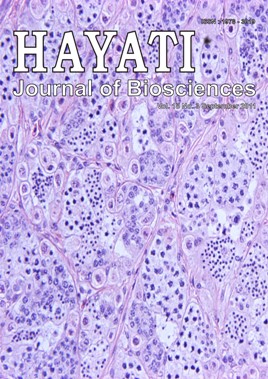<p class="MsoNormal" style="margin-bottom:.0001pt;text-align:justify;text-indent:14.15pt;line-height:normal;"><strong><span style="font-size:9pt;">A study with the aim to investigate the quality of <em>Gronotoma micromorpha</em> which attack the immature developmental stages of <em>Liriomyza huidobrensis</em> has been carried out. Such variables as body length measured from caput to the tip of abdomen, wing span and the length of tibia of hind leg were measured to represent parasitoid quality. The immature developmental stage period of the parasitoid was also recorded. The result indicated that a better quality <em>Gronotoma</em> was obtained when it was developed in the <em>Liriomyza</em> larvae fed on chinese cabbage with the average of 123.85 </span></strong><strong><span style="font-size:9pt;font-family:Symbol;">m</span></strong><strong><span style="font-size:9pt;">m for body length, 253.45 </span></strong><strong><span style="font-size:9pt;font-family:Symbol;">m</span></strong><strong><span style="font-size:9pt;">m for wing span, and 42.85 </span></strong><strong><span style="font-size:9pt;font-family:Symbol;">m</span></strong><strong><span style="font-size:9pt;">m for the length of hind tibia, respectively. When <em>Gronotoma</em> was developed in the <em>Liriomyza </em>larvae fed on soy bean, its size became smaller with the average of 97.7 </span></strong><strong><span style="font-size:9pt;font-family:Symbol;">m</span></strong><strong><span style="font-size:9pt;">m for body length, 214.3<em> </em></span></strong><strong><span style="font-size:9pt;font-family:Symbol;">m</span></strong><strong><span style="font-size:9pt;">m for wing span, and 37.2 </span></strong><strong><span style="font-size:9pt;font-family:Symbol;">m</span></strong><strong><span style="font-size:9pt;">m for the hind tibia. When it is developed in the <em>Liriomyza </em>on chinese cabbage host plant the immature developmental period of <em>Gronotoma</em> is sligthly shorter with the average of 18.4 and 17.3 days for which developed in the larvae and pupa respectively and on soy bean it become longer with the average of 19.2 days for in eggs, 19.9 days for that in the larvae. On chinese cabbage, <em>Liriomyza </em>tend to have bigger size for both flies and pupae.</span></strong></p>
Abstract
A study with the aim to investigate the quality of Gronotoma micromorpha which attack the immature developmental stages of Liriomyza huidobrensis has been carried out. Such variables as body length measured from caput to the tip of abdomen, wing span and the length of tibia of hind leg were measured to represent parasitoid quality. The immature developmental stage period of the parasitoid was also recorded. The result indicated that a better quality Gronotoma was obtained when it was developed in the Liriomyza larvae fed on chinese cabbage with the average of 123.85 mm for body length, 253.45 mm for wing span, and 42.85 mm for the length of hind tibia, respectively. When Gronotoma was developed in the Liriomyza larvae fed on soy bean, its size became smaller with the average of 97.7 mm for body length, 214.3 mm for wing span, and 37.2 mm for the hind tibia. When it is developed in the Liriomyza on chinese cabbage host plant the immature developmental period of Gronotoma is sligthly shorter with the average of 18.4 and 17.3 days for which developed in the larvae and pupa respectively and on soy bean it become longer with the average of 19.2 days for in eggs, 19.9 days for that in the larvae. On chinese cabbage, Liriomyza tend to have bigger size for both flies and pupae.
Downloads
HAYATI J Biosci is an open access journal and the article's license is CC-BY-NC. This license lets others distribute, remix, tweak, and build upon author's work, as long as they credit the original creation. Authors retain copyright and grant the journal/publisher non exclusive publishing rights with the work simultaneously licensed under a https://creativecommons.org/


















.png) IPB University
IPB University Department of Biology
Department of Biology The Indonesian Biological Society
The Indonesian Biological Society 

